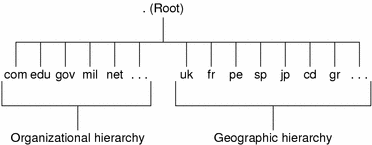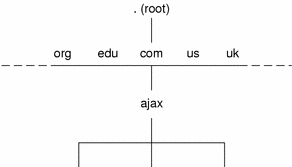DNS Hierarchy and the Internet
The domain hierarchy that is shown in the following figure is a “leaf” of the huge DNS namespace supported on the global Internet.
The figure consists of the root directory, which is represented as a dot (.), and two top level domain hierarchies, one organizational and one geographical. Note that the com domain introduced in this figure is one of a number of top-level organizational domains in existence on the Internet.
Figure 3–4 Hierarchy of Internet Domains

At the present time, the organizational hierarchy divides its namespace into the top-level domains listed in the following table. Additional top-level organizational domains can be added in the future.
Table 3–3 Internet Organizational Domains|
Domain |
Purpose |
|---|---|
|
com |
Commercial organizations |
|
edu |
Educational institutions |
|
gov |
Government institutions |
|
mil |
Military groups |
|
net |
Major network support centers |
|
org |
Nonprofit organizations and others |
|
int |
International organizations |
The geographic hierarchy assigns each country in the world a two or three-letter identifier. The hierarchy also provides official names for the geographic regions within each country. For example, domains in Britain are subdomains of the uk top-level domain, Japanese domains are subdomains of jp, and so on.
Joining the Internet
The Internet root domain, top-level domains, organizational and geographical, are maintained by the various Internet governing bodies. People with networks of any size can “join” the Internet by registering their domain name in either the organizational or the geographical hierarchy.
Every DNS domain must have a domain name. If you use DNS for naming service without connecting to the Internet, you can use any name for the domains and subdomains. However, if your site plans to join the Internet, your company must register its domain name with the Internet governing bodies.
To join the Internet, do the following.
-
Register your DNS domain name with the an appropriate Internet governing body.
-
Obtain a network IP address from that governing body.
There are two ways to accomplish this.
-
You can communicate directly with the appropriate Internet governing body or their agent.
-
You can contract with an Internet Service Provider (ISP) to assist you. ISPs provide a wide range of services from consulting to actually hosting your Internet presence.
-
Domain Names in the DNS Namespace
Domain names indicate a domain's position in the overall DNS namespace, much as path names indicate a file's position in the UNIX file system. After your local domain is registered, its name is added to the name of the Internet hierarchy to which the domain belongs. For example, the ajax domain that is shown in Figure 3–5 has been registered as part of the Internet com hierarchy. Therefore, its Internet domain name becomes ajax.com.
The following figure shows the position of the ajax.com domain in the DNS namespace on the Internet.
Figure 3–5 Ajax Domain's Position in the DNS Namespace

The ajax.com subdomains now have the following names.
sales.ajax.com test.ajax.com manf.ajax.com |
DNS domain names can be capitalized or in lower case. Here are some examples of machines and domain names.
boss.manf.ajax.com quota.sales.ajax.com |
The Internet organization grants each domain authority over the names of its hosts. The organization expects each domain to delegate authority to the levels below. Thus, the com domain has authority over the names of the hosts in its domain. The organization also authorizes the formation of the ajax.com domain and delegates authority over the names in that domain. The ajax.com domain then assigns names to the hosts in its domain. The ajax.com domain also approves the formation of the sales.ajax.com, test.ajax.com, and manf.ajax.com domains.
Fully Qualified Domain Names (FQDNs)
A domain name is said to be fully-qualified when the name includes the names of every DNS domain from the local domain on up to “.”, the DNS root domain. Conceptually, the fully qualified domain name indicates the path to the root, as does the absolute path name of a UNIX file. However, fully qualified domain names are read from lowest, on the left, to highest, on the right. Therefore, a fully-qualified domain name has the following syntax.

The fully qualified domain names for the ajax domain and its subdomains are:
ajax.com. sales.ajax.com. test.ajax.com. manf.ajax.com. |
Note the dot at the furthest right position of each name.
- © 2010, Oracle Corporation and/or its affiliates
